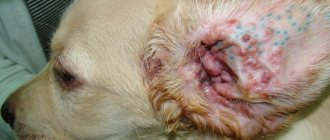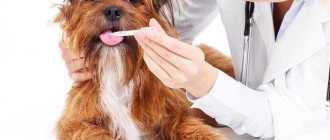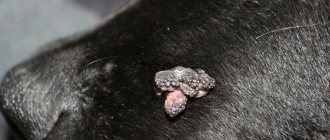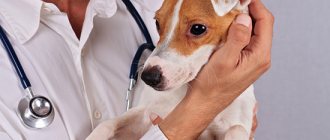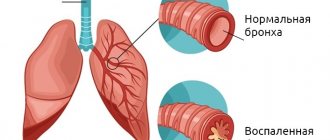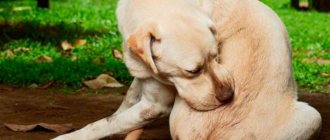Functions of the testes in the body
What functions of the testes in the body are most important?
Biologists and veterinarians find it difficult to answer this question, since the importance of these organs is difficult to overestimate:
- Reproductive. Spermatozoa mature in the testes and appendages of the organ. If there is something wrong with them, the sperm are “born” non-viable, with congenital developmental anomalies, they can no longer “make their way” through the female’s reproductive tract and cannot contribute to conception. Another option is that fertilization occurs, but the puppies are subsequently born non-viable, with a whole “bouquet” of genetic developmental anomalies.
- Hormonal. It is these organs that secrete testosterone, on which the dog’s health directly depends. In particular, if there is a lack of this hormone, the pet develops obesity, becomes apathetic, the amount of muscle tissue decreases, etc. An excess of testosterone is also extremely harmful, since in this case the risk of developing pathologies of the heart and blood vessels sharply increases.
What is orchitis and why is it dangerous?
Orchitis is inflammation of the testes. But! Only testes. Inflammation of the appendages is called epididymitis, and mixed pathology is called epididymitis orchioepididymitis. However, in practice, these pathologies are so interrelated that veterinarians still call them “orchitis”, regardless of the tissues involved in the inflammatory process.
Why is orchitis dangerous?
- Males very often remain infertile. For professional breeders and in the case of pets of rare breeds, this is a very unpleasant circumstance.
- In animals that have recovered from the disease, there is a decrease in testosterone levels . This, firstly, often leads to the impossibility of using them for breeding purposes. Secondly, a decrease in the level of sex hormones in itself is dangerous for the dog’s health, as we have already written about above.
- The testes are connected to the abdominal cavity by the inguinal canal. And if inflammation develops in the gland tissue, pathogenic microflora may well get there. In almost 100% of cases, this leads to severe peritonitis, often ending in the death of the pet.
Prevention of orchitis
Prevention measures include:
- genital hygiene;
- preventing uncontrolled sexual intercourse;
- examinations by a veterinarian, especially before mating;
- proper diet, daily routine, sufficient level of activity.
Large breeds are prone to orchitis, but it is not excluded in small pets either. It is important to vaccinate your dog on time and adhere to the prescribed schedule. In old male dogs, the inflammation can be chronic, in which case it is necessary to alleviate the animal’s condition.
If there is a sharp deterioration in health, the tumor has sharply started to grow, it is necessary to conduct research for malignant tumors. This is an indicator for medical castration.
Veterinarians strongly do not recommend treating the disease yourself or giving your pet antibiotics or immunosuppressants. Improper treatment can cause irreparable harm to health.
Causes of testicular inflammation in dogs
Practicing veterinarians identify the following reasons for the development of testicular inflammation in dogs:
- Injuries. “Courageous” males with intact testicles are quite cocky and aggressive creatures (especially during the heat period). Therefore, deep scratches and even wounds in such a delicate area are by no means uncommon. There are particularly “piquant” cases when dogs are brought to the veterinarian with their testicles bitten during a fight. In such situations, severe inflammation will definitely occur!
- Some infectious diseases. More precisely, almost any. If the pathogen gets into the blood, it can end up anywhere, including in the tissue of the testes.
- Abscesses, purulent dermatitis and other types of purulent inflammation in the scrotum area. With all these pathologies, the animal constantly scratches and rubs the genital area, which sharply increases the risk of infection.
- Diseases accompanied by profuse diarrhea. In these cases, the dog also constantly licks the groin area. Macerated (softened) skin is not a reliable barrier to pathogenic microflora. If the pet additionally starts scratching this area, it will definitely not be possible to do without serious consequences.
- Fungal infections . They are often a consequence of a significant deterioration of immunity; they also often develop against the background of profuse diarrhea (wet and “fertilized” skin).
- , severe hypothermia can cause inflammation .
Causes
Orchitis occurs in two forms - acute and chronic. The disease is usually caused by various injuries to the dog's scrotum. Infectious diseases such as are also causes.
The beginning of the development of the disease is the bite of various insects in the scrotum area. The following diseases provoke the onset of orchitis - in the groin,.
Symptoms
A male dog experiences swelling of the testes and irritation of the skin on the scrotum. The dog begins to lick her periodically. An external examination reveals open wounds.
When palpating the area of the testis, the dog experiences severe pain. There may be fever and pain. The dog constantly wants to sleep, does not want to walk, and refuses to eat.
Attempts to sit down become cautious, and tension in the hind limbs is noticeable. If orchitis takes a chronic form, then the male dog will not be able to have offspring in the future.
Diagnostics
An external examination is performed at the veterinary clinic. Tests are ordered to rule out other diseases that could be a potential trigger for orchitis.
If orchitis is infectious, blood tests will show a high balance of white cells. If you have cystitis or prostatitis, blood, proteins, and pus appear in the urine.
An ultrasound examination of the prostate and testes is also prescribed. If open wounds are present, examine for bacterial infections.
Prevention
If your dog is not intended for breeding, it is recommended to castrate him. If one testicle is affected, partial castration is used.
After surgery, the dog is given antibiotics for 3 weeks.
However, the use of antibiotics without castration usually does not have a positive effect. A male dog's sperm is always checked for activity, regardless of whether surgery has been performed or not.
To avoid infertility of your male dog, periodically conduct an external examination for open wounds and tumors. Treat your dog in a timely manner.
Testicular cancer in dogs is an oncological disease characterized by the appearance of a pathological neoplasm in the testicles, which is formed from the cellular structures of the gonads of animals. According to statistics, tumors of the testes make up 15-25% of all cancers of our smaller brothers. In veterinary practice, this pathology occurs in males of various age groups, but most often a tumor of the testes is diagnosed in uncastrated males after six to eight years. The main danger is the development of metastases. Moreover, if you identify signs of cancer in time, contact a veterinarian and begin treatment, the prognosis in most cases is favorable.
Not much different from human cancer. The disease develops due to cellular mutations that occur at the DNA level. Irreversible changes occur in the cells, as a result of which they cease to perform their natural functions. Due to rapid division, the number of mutating cellular structures increases, and they form into separate groups - tumors and daughter formations (metastases).
Neoplasms have
a malignant and benign nature
. Benign ones do not penetrate beyond the tissues in which they develop, so the prognosis in most cases with timely treatment is favorable.
Important! Pathological neoplasms compress tissues, blood vessels, nerves, displace, replace, and destroy healthy cells, which leads to disruption of the functioning of the affected organ.
Like any disease, a testicular tumor in a dog develops under the influence of various unfavorable exo- and endogenous factors, among which are:
- hormonal imbalance;
- genetic predisposition;
- age-related changes;
- endocrine diseases (hypoganadism);
- chronic pathologies of the reproductive system organs (inflammation of the appendages);
- severe injuries to the peritoneum and scrotum.
Testicular cancer is most often diagnosed in cryptorchid males. With cryptorchidism
, which can be unilateral or bilateral, one or two testes do not descend into the scrotum, but remain in the abdominal or groin area. The disease is transmitted genetically.
Important! Various forms of cryptorchidism in dogs increase the risk of neoplasms in an undescended testicle by 15 times. In 30-35% of cases, testicular cancer is diagnosed in males with bilateral cryptorchidism, in which both testicles are located in the intra-abdominal cavity.
Testicular cancer in dogs often develops after cancer, since the disease is recurrent, and also against the background of some viral, bacterial diseases, and infections. Classification of testicular cancer
Pathological neoplasms in the testes have different histological structures and etiopathogenesis. There are germinogenic, which arise from the seminiferous epithelium, and non-germinogenic, which are formed from the stromal epithelium, cellular structures that produce hormones.
There are three main types of testicular cancer diagnosed in dogs:
- Leydig tumor
(leydigoma). They develop in the descended testicles of males from interstitial cellular structures. They do not reach large sizes. They produce androgens, which leads to the formation of a constant hormonal background, which provokes the formation of tumors. Leydigomas are benign tumors and do not metastasize. - Seminomas.
They are formed from the cellular structures of the spermatic epthelium in the undescended testicle. Reach significant sizes. They do not produce hormones. Most often noted in males after 9-11 years. Metastasizes rarely, mainly to regional lymph nodes. - Sertoliomas.
Neoplasms that are formed from Sertoli cells. Produce estrogens. Changes in hormonal levels suppress secondary sexual characteristics in males. - Androblastomas
. Characterized by metastasis to other internal organs. Produce estrogens.
It is worth noting that tumors in dogs are quite often formed by various types of cancer cells. For example, in practice there are tumors of the testis (leidigoma) and cancer of the appendages. The most common type of testicular cancer in animals is germ cell tumors.
Symptoms and first signs of the disease
The owner needs to pay attention to the following symptoms and first signs of the disease:
- The testicles swell, swell, become very painful, and the local body temperature rises significantly.
- The same symptoms are observed with simultaneous damage to the testicular appendages.
- As a rule, inflammation does not bypass the scrotum. Its skin also swells, becomes inflamed, cracks and wounds may appear on it, and the animal constantly licks the scrotal sac.
- The dog tries not to move again, for fear of disturbing his sore testicles.
- There is a complete or partial refusal to eat, but thirst in many cases intensifies.
- In severe cases of the disease, fever may develop. Most often of a constant type, less often of an intermittent type.
- As we wrote above, the animal constantly licks and scratches the scrotum area.
- The dog becomes very “shy”. He tries to hide in the farthest and darkest corner so that no one will bother him.
- In the most severe cases, the testicles hurt so much that the animal frantically gnaws and bites them. This is fraught with extremely serious consequences, including the need for castration.
Diagnosis of inflammation in a clinical setting
Often, diagnosing inflammation in a clinical setting does not cause any difficulties. An experienced specialist is able to accurately make a diagnosis, focusing only on clinical signs.
But still, more advanced techniques are used to clarify the diagnosis:
- Palpation of the affected organ . It gives an idea of the consistency of the tissues, the intensity of the pain reaction, the presence of exudate in the scrotal cavity, etc. There is only one drawback - the animal experiences very severe pain, and therefore during the study it must be very well fixed.
- Biopsy. In this case, a sample of organ tissue is taken for subsequent microscopic examination.
- Blood tests are carried out. This method will not help diagnose “orchitis in a dog,” but it does provide a lot of valuable information. For example, about the strength and potential danger of the inflammatory reaction (based on the number of leukocytes).
- Sometimes an ultrasound of the scrotum may be required. The technique allows you to visually assess the condition of the testicular tissues.
Diagnosis and treatment
Only a veterinarian can determine the cause of the pathology. During the consultation, he will perform a number of diagnostic procedures:
- Collecting anamnesis by interviewing the owner. Information about the pet’s life, nutrition, and previous diseases will be important. The owner must describe observed behavioral abnormalities.
- Inspection. The veterinarian will palpate the scrotum and determine the size of the swelling and the color of the skin in the affected area.
- Laboratory tests (blood, urine) to determine the presence of inflammatory processes.
- Ultrasound diagnostics of the scrotum and abdominal organs.
- Taking biological material (biopsy) - identifying the causative agent of the disease.
After determining the cause, the veterinarian will prescribe a course of treatment aimed at eliminating it and relieving symptoms. If a dog’s testicles are swollen, then a general algorithm of therapeutic procedures is carried out:
- If the cable is not breeding (not used for breeding), then castration with complete removal of the testicles is recommended. If one testis is affected, only that one is removed.
- Prescription of antibiotics: Amoxicillin, Ceftriaxone, Ceftazidime. The course is long with maximum doses to preserve reproductive function. Regular blood tests are recommended.
- Hepatoprotectors – Hepatovet, Covertal, Legafiton. Probiotics – Lactobifadol, Bifidum, Fortiflora, Bactoneotim.
- Antifungal drugs if orchitis is caused by mycosis. For allergies - diet, antihistamines (Suprastin, Tavegil, Diazolin).
Orchitis is an inflammation of the testes, which is better to prevent than to treat, so preventive measures are recommended: vaccination, regular examinations, timely treatment of infections.
Treatment regimen for testicular inflammation in dogs
The most typical and common treatment regimen for testicular inflammation in dogs is:
- In the most severe cases (usually purulent orchitis), castration is strongly recommended! Without testicles, the dog will live perfectly (even longer than with them), but sepsis and/or purulent peritonitis will definitely bring him to the grave.
- If orchitis is definitely of a traumatic nature, then in the first hours after damage to the testicles, cold can be applied to them. Approximately on the third day from the moment the first symptoms appear, paraffin applications can be used. But heat should never be applied in the first hours or days after injury! This will only worsen the course of the disease.
- With a milder and more moderate course of the disease, the dog is prescribed loading doses of broad-spectrum antibiotics . Sometimes veterinarians prescribe other antimicrobial drugs.
- Inflammation can also be controlled with non-steroidal anti-inflammatory drugs.
- Painful attacks are relieved using suitable painkillers.
- To improve the dog's general condition, speed up recovery and strengthen its immunity, multivitamin preparations can be used.
- Novocaine blockades with antibiotics are mandatory.
Clinical manifestations
Regardless of the histological structure and type of tumor. Testicular cancer in males is characterized by a predominantly slow progression. At the beginning of the development of pathology, with a detailed visual examination and palpation, you can notice a small painless compaction in the affected testis, which gradually increases in size.
Important! Neoplasms develop in males in one or two testicles. When a tumor develops in one testicle, the second one atrophies.
Symptoms of testicular cancer in dogs and the intensity of manifestations of cancer depend on the location of the tumor, the type, structure of the tumor, age, and physiological characteristics of the animal’s body.
The initial symptoms of testicular cancer in animals resemble acute orchiepididymitis. As the disease progresses, the scrotum is asymmetrically enlarged and swollen. Further development is associated with the appearance of metastases.
General clinical picture:
- enlarged testicles;
- swelling of one or two testicles;
- change in urine color (blood, clots);
- painful urination, polyuria. defecation disorder;
- infertility;
- enlargement of regional lymph nodes (lymphadenopathy);
- sudden weight loss, cachexia;
- depression, decreased activity;
- increased thirst;
- pain on palpation of the peritoneum, abdominal distension;
- decreased sexual activity;
- swelling of the penis, mammary glands.
With sertoliomas in dogs, general depression and deterioration in the condition of the coat are noted. The fur becomes matte and brittle. Symmetrical hairless areas are noticeable on the sternum and hind legs. The skin of the scrotum is thickened. The mammary glands are enlarged.
When nerve endings are compressed, dogs experience pain in the back and croup. If the lymph nodes are affected, lymphostasis develops along the lymphatic pathways, and the limbs swell. When the intestines are compressed, the act of defecation is disrupted due to intestinal obstruction. Compression of the ureters leads to hydronephrosis.
In non-germinogenic forms of cancer, hormonal levels and behavior change. Males lose interest in females and may experience sexual attraction to males.
List of drugs and antibiotics
Here is an approximate list of drugs and antibiotics used in the treatment of orchitis:
- For novocaine blockades, novocaine is used in the form of a 0.5% solution. It must be warm and fresh, otherwise there will be no pronounced therapeutic effect.
- Antibiotics are used from the cephalosporin group (Ceftriaxone, for example), but in severe cases, drugs from the tetracycline group (Doxycycline) may be required. When performing novocaine blockades, benzylpenicillin sodium salt can be used.
- Multivitamin preparations - Tetravit, Vittri, Trivit, Stride Plus.
- Regular analgin can be used as a pain reliever.
Caring for a sick dog at home
Proper care of a sick dog at home is of great importance:
- The dog is given complete rest and is not disturbed or disturbed.
- Take him out for walks only when the outside temperature is adequate, and no more than 10-15 minutes at a time.
- To simplify treatment, it is better to cut the hair in the scrotum area.
- Feed with high-quality canned food or natural food. Food should taste good and be nutritious.
- A dog that has recovered from an illness can be mated no earlier than two months after complete recovery. The fact is that only by this time is normal spermatogenesis restored.
It is necessary to strictly follow all the veterinarian’s prescriptions.


